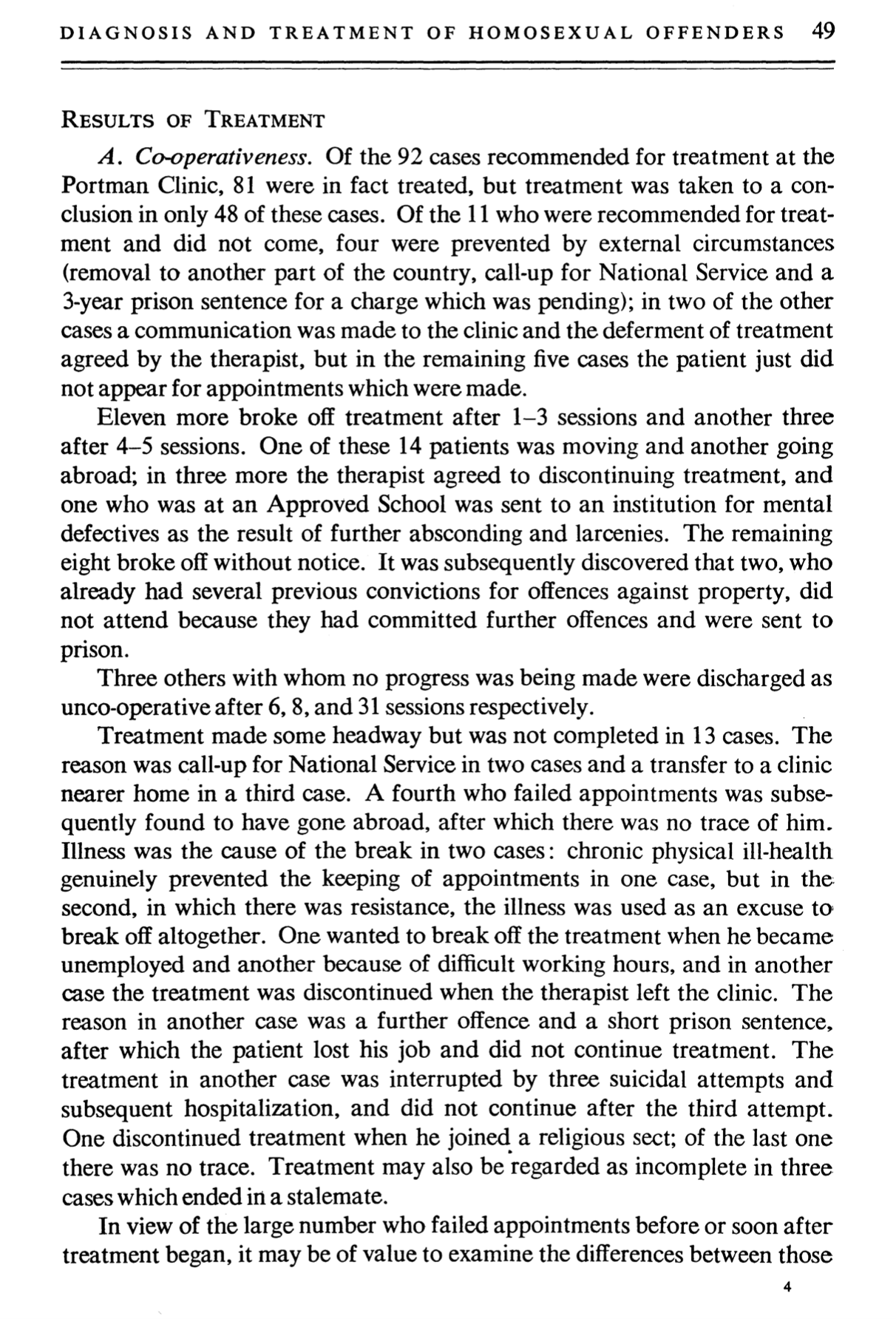The British Journal of Delinquency published results of treatment of homosexuals with 65% (31 of 48) shifting towards heterosexuality from those that completed treatment.
- Type
- Academic / Technical Report
- Source
- Mary Woodward Non-LDS
- Hearsay
- Direct
- Reference
Mary Woodward, "Diagnosis and Treatment of Homosexual Offenders," The British Journal of Delinquency 9, no. 1 (July, 1958): 44-59
- Scribe/Publisher
- The British Journal of Delinquency
- People
- Mary Woodward
- Audience
- Reading Public
- Transcription
THE DIAGNOSIS AND TREATMENT OF HOMOSEXUAL OFFENDERS
A Clinical Survey
By MARY WOODWARD (London)
INTRODUCTION
Appended to the evidence submitted to the Departmental Committee on Homosexuality and Prostitution by a joint committee of the I.S.T.D. and the Portman Clinic was an analysis of the diagnosis and treatment records of homosexual cases discharged from the Portman Clinic during 1952 an 1953. A more detailed examination of these records was subsequently made, and the amplified findings are repeated below.
The years 1952 and 1953 were chosen in order to allow a period of at least 18 months after discharge before follow-up data were gathered; most of the cases were referred between 1950 and 1953. As is usual with the case history method, there was not in every case information on every aspect it was desired to investigate, but only two cases were discarded because of insufficient data; the remaining 113 were complete in respect of the more essential points.
Description of the Group
Ten of the 113 cases were juveniles, five of whom were under 14 ye another nine were aged 17 to 20 years. Of the remaining 94, who were 21 years and over, about half (45) were under 30 and another 26 were 30 to 40; five were over 60.1 The majority of the Clinic cases were ten were married at the time of referral and six separated, widow divorced.
. . .
Results of Treatment
A. Co-operativeness. Of the 92 cases recommended for treatment a Portman Clinic, 81 were in fact treated, but treatment was taken to conclusion in only 48 of these cases. Of the 11 who were recommended for treatment and did not come, four were prevented by external circumstances (removal to another part of the country, call-up for National Service and a 3-year prison sentence for a charge which was pending); in two of the cases a communication was made to the clinic and the deferment of treatment to agreed by the therapist, but in the remaining five cases the patient just did not appear for appointments which were made.
Eleven more broke off treatment after 1-3 sessions and another three after 4-5 sessions. One of these 14 patients was moving and another going abroad; in three more the therapist agreed to discontinuing treatment, and one who was at an Approved School was sent to an institution for mental defectives as the result of further absconding and larcenies. The remaining eight broke off without notice. It was subsequently discovered that two, who already had several previous convictions for offences against property, did not attend because they had committed further offences and were sent to prison.
Three others with whom no progress was being made were discharged as unco-operative after 6,8, and 31 sessions respectively.
Treatment made some headway but was not completed in 13 cases. The reason was call-up for National Service in two cases and a transfer to a clinic nearer home in a third case. A fourth who failed appointments was subsequently found to have gone abroad, after which there was no trace of him. Illness was the cause of the break in two cases ; chronic physical ill-health genuinely prevented the keeping of appointments in one case, but in the second, in which there was resistance, the illness was used as an excuse to break off altogether. One wanted to break off the treatment when he became unemployed and another because of difficult working hours, and in another case the treatment was discontinued when the therapist left the clinic. The reason in another case was a further offence and a short prison sentence, after which the patient lost his job and did not continue treatment. The treatment in another case was interrupted by three suicidal attempts and subsequent hospitalization, and did not continue after the third attempt. One discontinued treatment when he joined a religious sect; of the last one there was no trace. Treatment may also be regarded as incomplete in three cases which ended in a stalemate.
. . .
Psychotherapy alone was the method used in all but five cases which were also treated with the hormone method. (Of the 14 who discontinued treatment after 1-5 sessions, three were having hormone treatment, the rest psychotherapy).
It is naturally not to be expected that treatment would result in all cases in a loss of the homosexual impulse. As can be seen from Table V, this occurred in only 29 cases, though the 31 who achieved great control or acted with greater discretion with or without a diminution of the homosexual impulse, may be considered to have benefited from treatment, particularly from the point of view of criminality, if not from the medical standpoint of cure. This only four cases were failures, though the case in which the Court appearance was followed by a loss of all conscious sexual desire should also perhaps be regarded as unsatisfactory with a possible risk of further offences. As might be expected, treatment resulting in a loss of homosexual impulse had, with one exception, been completed.
- Source Link
- https://www.jstor.org/stable/23640855
- Citations in Mormonr Qnas
The B. H. Roberts Foundation is not owned by, operated by, or affiliated with the Church of Jesus Christ of Latter-day Saints.





